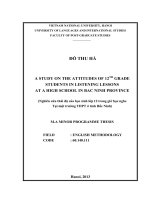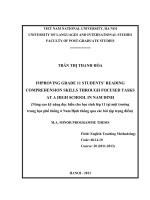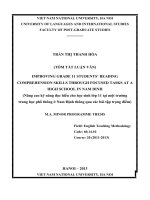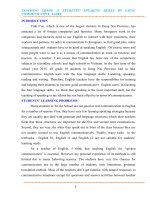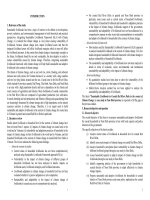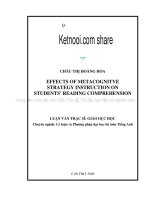SUMMARY OF THESIS IMPROVING GRADE 11 STUDENTS’ READING COMPREHENSION SKILLS THROUGH FOCUSED TASKS AT A HIGH SCHOOL IN NAM DINH
Bạn đang xem bản rút gọn của tài liệu. Xem và tải ngay bản đầy đủ của tài liệu tại đây (150.27 KB, 18 trang )
VIET NAM NATIONAL UNIVERSITY, HA NOI
UNIVERSITY OF LANGUAGES AND INTERNATIONAL STUDIES
FACULTY OF POST-GRADUATE STUDIES
TRẦN THỊ THANH HÒA
(TÓM TẮT LUẬN VĂN)
IMPROVING GRADE 11 STUDENTS’ READING
COMPREHENSION SKILLS THROUGH FOCUSED TASKS AT A
HIGH SCHOOL IN NAM DINH
(Nâng cao kỹ năng đọc hiểu cho học sinh lớp 11 tại một trường
trung học phổ thông ở Nam Định thông qua các bài tập trọng điểm)
M.A. MINOR PROGRAMME THESIS
Field: English Teaching Methodology
Code: 60.14.10
Course: 20 (2011-2013)
HANOI – 2013
VIET NAM NATIONAL UNIVERSITY, HA NOI
UNIVERSITY OF LANGUAGES AND INTERNATIONAL STUDIES
FACULTY OF POST-GRADUATE STUDIES
TRẦN THỊ THANH HÒA
(TÓM TẮT LUẬN VĂN)
IMPROVING GRADE 11 STUDENTS’ READING
COMPREHENSION SKILLS THROUGH FOCUSED TASKS AT A
HIGH SCHOOL IN NAM DINH
(Nâng cao kỹ năng đọc hiểu cho học sinh lớp 11 tại một trường
trung học phổ thông ở Nam Định thông qua các bài tập trọng điểm)
M.A. MINOR PROGRAMME THESIS
Field: English Teaching Methodology
Code: 60.14.10
Course: 20 (2011-2013)
Supervisor: Assoc.Prof. Dr. Nguyễn Văn Độ
HANOI – 2013
PART I: INTRODUCTION
I. Rationale
Language itself plays an important part in our daily life and it is the
most effective means of communication. Language distinguishes man from
animals. That is because language is an effective means of information,
transaction and interaction making experience so we can say that without
language there would be no civilization, no culture, no intervention and no
progress. Nowadays, the demand of communication among people in all
countries is greater, therefore it is really necessary for everyone to learn at
least one foreign language.
In our country, English is widely taught and learnt because it is an
international language used in all aspects of life such as tourism,
technology, literature, commerce and so on. Especially, English has become
a compulsory in high schools. That is why it is vital to find out to teach and
learn English effectively.
Teaching English involves four skills: speaking, listening, reading
and writing. Among them, teaching reading plays an important role for high
school students in enriching their general knowledge, enlarging their
vocabulary and in helping them with their further study later. Reading also
contributes to the development of other language skills. When teaching
reading, some issues may arise such as how to assess students’ reading
ability, how to give tests to students, techniques to improve students’
reading skills and so on. Among these issues, I choose to do my research on
the project entitled “Improving Grade 11 Students’ Reading
Comprehension Skills through Focused Tasks at A High School in Nam
Dinh” because I myself believe that reading can help learners to get
1
information to the fullest, and that providing learners with useful techniques
and tasks will motivate them in reading.
II. Aims of the study
The study is aimed at:
1) better understanding the concepts of reading, content reading,
reading comprehension.
2) identifying some problems in teaching and learning reading English
at Ngo Quyen High School in Nam Dinh.
3) providing the 11
th
grade students at Ngo Quyen High School with
useful focused tasks to improve reading comprehension skills.
The study is the hope of the author to make some contributions to the
improvement of reading comprehension skills for the 11
th
form students .
III. Scope of the study
The study on reading in general is immense and covering every
aspect of language theory and practice in this study is impossible. Due to
the time limitation, only one small aspect of reading comprehension is
mentioned to, that is reading comprehension tasks. Some focused tasks to
help teachers and students better in teaching and learning reading
comprehension would be recommended.
IV. Methodology
In seeking answers to the research questions, survey questionnaires
and class observations were chosen to obtain relevant information for the
study. The strategic method of the study is quantitative one. That is all
remarks, considerations, and conclusions are made largely based on the
2
analysis of the statistic data collected through the survey questionnaires.
Class observations are carried out as a supplementary to the survey
questionnaires.
V. Design of the study
The study consists of three main parts: the Introduction, the
Development and the Conclusion.
Part I introduces rationales, aims of the study, scope and methods of the
study.
Part II comprises four chapters.
Chapter I deals with an overview of the theoretical background of the
research. It is concerned with the issues relevant to the topic of the research:
reading and reading comprehension, classification of reading, the
importance of improving reading skills, roles of reading teachers and those
of reading students, focused tasks in reading .
Chapter II describes the participants and instruments of the study.
Chapter III is data collection and data analysis.
Chapter IV offers some focused tasks to improve reading comprehension
skills and a sample work.
Part III summarizes the issues addressed and presents recommendations
for further improvements and some suggestions for further research.
3
PART II: DEVELOPMENT
CHAPTER I: THEORETICAL BACKGROUND
I.1. Definitions of reading, reading comprehension and purposes of
reading
I.1.1. What is reading?
Reading is a natural and common activity that people always do in
their daily life. It is stated that reading is a kind of culture that people
regardless of age, sex, or class should learn and have. Although no one can
deny the high frequency of reading in everyday life, to understand
thoroughly what reading or reading comprehension is may not be well
aware by many. There have been so many definitions of reading that they
cause much confusion. Hence, many linguists take reading into account to
do research. They have studied and given various definitions of reading.
According to Frank Smith (1978:2) “reading is to understand the
author’s thought”. He also adds “Understanding print or even receiving
communication can hardly be said to explain reading. The problem still
remains of how readers understand the print or receives the
communication”. This means that readers need to understand the author’s
mind, not the author’s words. The meaning of a word on any particular
occasion will depend largely on the context in which it occurs. So when
readers understand the author’s thought, they are successful in reading
because the nature of reading is the interaction between writers and readers.
Reading is much more than just understanding individual words but it is the
process that the writer and reader understand each other.
I.1.2. What is reading comprehension?
4
Reading comprehension takes a very important part in teaching and
learning reading a language and a foreign language as well. Reading
comprehension is a process that requires how to decode through the
development of an extensive repertoire of sight words, learning the
meanings of vocabulary words encountered in the texts, and learning how
to abstract meaning from text. It represents how well readers understand
literal comprehension which concentrates on explicit meaning and
inferential comprehension which concentrates on implicit meaning in the
reading text.
I.1.3. The purposes of reading
The purposes of reading will determine how we read, what skills
we need and what types of reading text we practise in order to fulfill the
purposes. There are three main purposes of reading: reading for pleasure,
reading for information and reading for language development.
Reading for pleasure is considered as a purpose of reading because
some people only read for entertainment, especially when getting stressed
or after their hard working hours. They read funny stories, jokes,
newspapers and articles to entertain themselves. In language classroom,
reading for pleasure is used to lessen tension in class through funny stories,
spicy stories, etc.
Reading for information means that readers have to find out
something or do something with information they get. Information may be
presented in several ways in written or spoken language, in drawings,
photographs, etc.
Reading in a foreign language is an effective way to learn a
language for students. Through reading they can get the content of the
5
subject which they are studying and get the way to develop their
knowledge of language itself.
In general, reading skills will make other skills such as speaking,
writing and listening improve because by teaching reading, the teacher
provides students knowledge that can be used in writing, speaking and
listening.
I.2. Classification of reading
I.2.1. Classification of reading according to manner
According to manner, reading aloud and silent reading are two
types of reading in which “reading aloud involves looking at the text,
understanding it and also saying it” (Doff, 1988:70). Although reading
aloud is considered a way to convey necessary information to the others, it
is an unpopular activity outside classroom.
I.2.2. Classification of reading according to purposes
It is clear to assume that the reasons for reading are different from
this person to that person because of their uncommon purposes. According
to purposes, reading is categorized into skimming, scanning, intensive
reading and extensive reading.
I.3. Stages in a reading lesson
Activities in a reading lesson can be divided into three stages: pre-
reading stage, while-reading stage and post-reading stage. For each stage,
different techniques should be used to help students read the text
comprehensively.
I.3.1. Pre-reading stage
According to Williams (1984:37), the purposes of the pre-reading
6
stage are:
- To introduce and arouse interest in the topic.
- To motivate learners by giving a reason for reading.
- To provide some language preparation for the text.
Normally, pre-reading phase often last from two to ten minutes
depending on each lesson. Several techniques are suggested such as using
pictures, predicting from the titles, guessing and brainstorming to see what
students have already known. These activities are aimed at drawing the
students’ interest towards reading as well as preparing them for the reading
text.
I.3.2. While-reading stage
Williams (1984:38) states that while-reading stage is the main part
of a reading lesson with the following specific aims:
- To help understanding of the writer’s purpose.
- To help understanding of the text structure.
- To clarify text content.
At this stage, there is a great deal of activities can be performed in order to
help students to understand the text. The teacher acts as an organisor, a
helper only. He will be available to help individuals with their particular
difficulties. He will be likely to be about the meaning of new vocabulary
items, new grammar structures, etc. In this situation, he should encourage
students to guess the meaning from the context.
On the whole, the teacher must manage his class in such a way every
student participates in the lesson and understands the text.
I.3.3. Post-reading stage
After reading, the teacher needs to consolidate or reflect upon what
7
has been read. Williams stated that “the post-reading stage is aimed at
consolidating or reflecting upon what has been read and relating the text to
the learners’ own knowledge, interests or views” Williams (1984:39). This
stage is where integration of four skills will be appropriately conducted.
Activities in this stage are aimed at helping students apply what they have
learnt from the text to their further study or communication through the
tasks provided by the teacher.
Obviously, the three-phase approach is not to be carried out
mechanically on every occasion. Sometimes, the teacher may wish to cut
out the pre-reading stage and get learners to work on the text directly. At
other times, post-reading stage may not be included.
I.4. Factors in teaching and learning reading
I.4.1. The role of the teacher
In a reading lesson, the teacher acts as a helper and students work
individually and actively but this does not mean that there is nothing for the
teacher to do. The roles of teachers in an EFL reading lesson are also
significant and worth mentioning.
I.4.2. The role of students
The students are the heart of the reading process in a reading class and they
can make a reading lesson successful. Nuttall (2000:33) mentions several
main roles for the students in a reading lesson. They are as follows:
- Taking an active part in learnin
- Monitoring comprehension
- Learning text talk
- Taking risks
- Learning not to cheat oneself
8
I.4.3. The role of reading texts
Texts plays an important role in a reading lesson. That is because
text is used “as a way of learning new language by looking at the text and
focusing on particular words and expression” Doff (1988:62). This means
that through reading text, students can understand phonetic, lexical and
grammatical items. Besides, students can enrich their knowledge in
different fields such as science, technology, culture, art etc in the target
language.
I.5. Factors determining successful reading comprehension
I.5.1. Considerations for students
Language learners can learn to use different kinds of reading
strategies. Some read and understand a text very quickly while others read
slowly and fail to understand what they read and it is essential to take the
following elements into consideration on the part of students.
I.5.2. Considerations for teachers
Teachers take an important role in improving the students’ reading.
They must know how to convey or present a reading lesson to students. It is
really necessary to take the following elements into considerations for
teachers.
I.6. Focused tasks and using tasks to develop reading comprehension
skills
I.6.1. Focused tasks
According to Breen (1989), a task is “a structured plan for the
provision of opportunities for the refinement of knowledge and capabilities
9
entailed in a new language and its use during communication. He
specifically states that a task can be a brief practice exercise or a more
complex work plan that requires spontaneous communication of meaning.
Focused asks, according to Ellis (2003), aim to introduce learners
to process, receptively or productively, some particular linguistic feature,
for example, a grammatical structure. He says that focused tasks have two
aims: one is to stimulate communicative language use, the other is to target
the use of a particular, predetermined target feature.
I.6.2. Using tasks to develop reading comprehension skills
I.6.2.1. Skills involved in reading
Readers need variety of skills when reading. In fact, a change in
purpose of reading usually results in the change in the reading skills so the
type of reading performed. According to Tomlinson and Ellis (1980:150),
reading skills include: mechanical skills, understanding the lexical items,
understanding grammatical meaning, reasoning skills, selection skills and
evaluation skills.
Another possible way of classification of reading skills is suggested
by Grellet (1981:4). He considers that reading skills consist of: recognising
the scrift of a language, deducing the meaning and use of unfamiliar lexical
items, understanding explicitly stated information, understanding
information what not explicitly stated, understanding conceptual meaning,
understanding the relations within the sentence, understanding relations
between parts of the text through grammatical cohesion devices,
interpreting a text by going outside it, recognising indicators in discourse,
identifying the main point or important information in a piece of discourse,
distinguishing the main idea and supporting details, extracting salient points
10
to summarise, basic reference skills, skimming, scanning and transcoding
information to diagrammatical display.
I.6.2.2. Questions and tasks in a reading lesson
In teaching reading, reading lessons have been traditionally based
on passage followed by questions and tasks. The aim of which is to check
understanding rather than to produce understanding. Introducing questions
and tasks will encourage students to anticipate the content of a text from its
title and illustrations. Questioning and tasks, therefore, are very important
to improve the students’ reading comprehension.
There must be variety in the range of tasks and it is necessary if
different reading skills are to be covered. A task should not always imposed
on a text and it is better to allow the text to suggest what tasks are most
appropriate. There are various ways of classifying types of questions and
tasks. According to Nuttual (1989:434), there are five types of questions
and tasks such as: questions of literal comprehension, questions involving
recognition or interpretation, questions of inference, questions of valuation
and questions of personal response. Questions and tasks are one of the best
ways of building up the students’ comprehension reading skills and their
confidence.
CHAPTER II: METHODOLOGY
II.1. Situation analysis
II.1.1. Setting of the Study
The study was conducted at Ngo Quyen High School in Nam Dinh.
English is a compulsory subject and one of the core subjects at high
schools. Reading is a skill of major concern in teaching-learning English in
11
Vietnam. During a reading lesson, the teacher asks students to read a text
and then he or she explains new words or structures to help students
understand the text. The reading lesson sometimes turns out to be an
English-Vietnamese translation lesson. Translation can be used as an
effective way of teaching reading for some texts only. However, in reading
lesson if the teacher uses translation, it will lead to inefficient reading and it
also makes the students inactive and dependent. Consequently, the teaching
reading process cannot be considered as efficient. The problem which is
raised here is how to make the reading lessons efficient and how to develop
reading comprehension skills for students. This should, therefore, be taken
into consideration in teaching reading lessons. It is possible to introduce
questions and tasks which encourage students to anticipate the contents of
reading texts. For that reason, the teacher should ask students to do a variety
of tasks to understand the texts and to develop reading comprehension
skills.
II.1.2. Participants
The process of data collection involved the participation of both
teachers of English (8 teachers) and grade 11 students (155 students) who
are teaching and learning at Ngo Quyen High School in Nam Dinh as
follows:
II.1.3. Reading Materials
The materials used for teaching and learning English for the grade
11 students are English course books TIENG ANH 11. The textbook
consists of 16 units organized broad topics. Each unit is divided into 5
parts: Reading, Speaking, Listening, Writing and Language Focus. The
teacher only covers one of the above five parts in each period.
12
II.2. Instrumentation
The sample was drawn from two sources: from 155 students and
from 8 teachers teaching at Ngo Quyen High School in Nam Dinh.
CHAPTER III: DATA ANALYSIS AND FINDINGS
III.1. Data analysis and findings
In this part, the collected data will be illustrated on charts, tables
and graphs. Each chart, table or graph is followed by an analysis of the data.
III.1.1. Survey for students
III.1.1.1. Students’ attitudes towards learning reading skills
Question 1: Do you like reading English?
Question 2: What is your purpose of reading English?
Question 3: What kinds of reading materials do you like to read?
III.1.1.2. Learning reading skills of the 11
th
form students
Question 4: Which kinds of tasks are you often asked to do?
Question 5: What are your difficulties in doing reading tasks?
Question 7: What do you usually do when you come across a new
word while you are reading?
Question 8: Besides tasks in the textbook, do you like to do
supplementary tasks to improve your reading comprehension skills?
III.1.1.3. The attitude of students towards the role of the teacher
Question 9: You think that the role of the teacher as a guide in
doing reading tasks is:
III.1.1.4. The self-assessment of the students about their reading
Question 10: How do you self-evaluate your reading proficiency?
III.1.2. Survey for teachers
13
Question 1: What do you think about the reading texts and tasks
in the textbook?
Question 2: Which kinds of tasks do you give to your students?
Question 3: Do you think reading tasks in the textbook are
enough for the students?
Question 4: Do you think it is necessary to give your students
training in doing reading tasks?
Question 5: Do you explain new words and structures before or
after your students read the texts?
Question 6: Which problems do your students often meet in
reading and doing reading tasks?
Question 7: How do you teach your students to do reading tasks?
III.2. Classroom observation
The researcher came to observe class 11B with Unit 4, class 11A
with unit, class 11D with unit 11, and class11G with unit 12.
In conclusion, the survey questionnaires and classroom observation
help find out the techniques of teaching reading tasks in high school. We
can see that some teachers have not found the best ways to teach reading
comprehension skills to students. I think that teachers should improve their
teaching methods to help students in learning reading comprehension skills.
CHAPTER IV: SUGGESTED SOME FOCUSED TASKS IN
TEACHING READING SKILLS AND SAMPLE WORK
IV.1. Suggested some focused tasks in teaching reading skills
IV.1.2. Suggested some focused tasks
IV.1.2.1. Suitability for students’ level
14
It is the fact that classes are large and mixed ability ones. Students
are of different levels ranking from advanced to weak students. If the
teacher gives a difficult exercise, the advanced will be motivated and the
rest will lose their interest so the teacher should give exercises which are
suitable for students’ levels, This study will focus on three kinds of reading
tasks: dealing with unfamiliar words, complex sentences comprehension
and whole-text comprehension.
IV.1.2.2. Suitability for reading purposes
As mentioned in the first chapter, there are three main purposes of
reading: reading for pleasure, reading for information and reading for
language development. Purposes of reading determine the types of reading
and the relevant reading skills to be used. Thus, in the teaching process, it is
advisable for the teacher to pay much attention to the suitability of tasks for
different purposes of reading. However, in this study I mainly focus on
reading for language development.
Through doing reading tasks, students can upgrade their mastery of
the target language. In doing reading tasks, students can have a useful
practice in the development of reading skills such as skimming, scanning,
etc. In this study, some kinds of tasks are suggested so that the teachers can
use them to develop those skills in students at high schools, especially the
11
th
form students.
IV.2. Sample work
Unit 16 - The Wonders of the World (TIENG ANH 11, 2007:179)
15
PART III: CONCLUSION
The thesis has presented some useful techniques accompanied by a
number of focused tasks to develop certain reading comprehension skills
for students. Students can skim for the gist, and then scan to locate for
specific information or read more for further understanding. All these tasks
are suggested basing on the theory of reading and teaching reading
comprehension. It is also based on the present situation of teaching and
learning reading at Ngo Quyen High School. The actual teaching and
learning status was clarified through the two survey questionnaires and
some classroom observations at Ngo Quyen High School. The statistics
indicates that both students and teachers have positive attitudes toward
teaching and learning reading, but reading tasks which the teachers used
were not sufficient enough to develop their students’ reading
comprehension skills. It is advisable for them to give more tasks in their
reading lessons.
16


